Using Obsidian, The First Two Years
I have been using Obsidian for my note-taking efforts for almost two years now, from the beginning of 2022, and it has stuck with me. I think I’m still improving the ways I’m using Obsidian, which is a good sign. I love that I have found a way of storing my notes in clear text format, and the Obsidian way of using links is making those notes and the process of creating them so much more valuable and enjoyable.
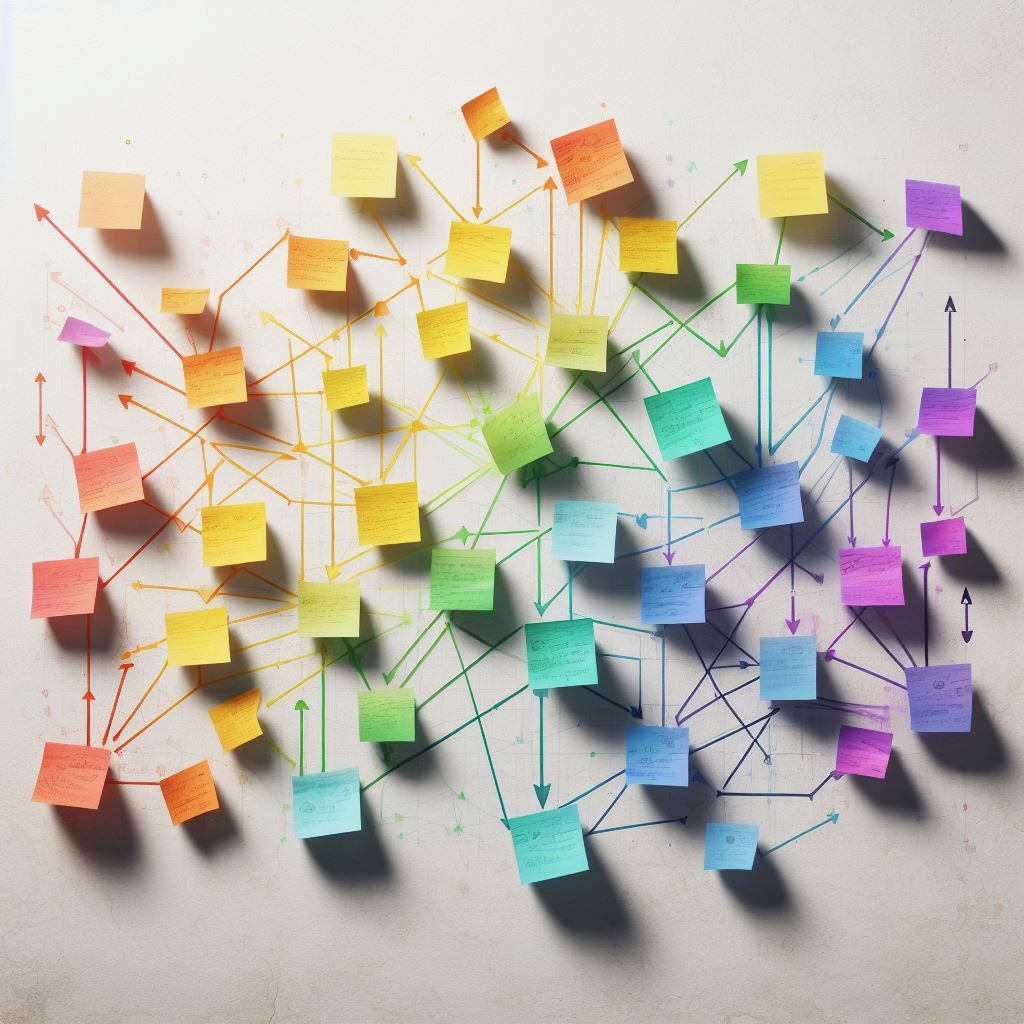
I try to minimize the amount of plugins I use and stick to the built-in ones. I may start using something like the Obsidian Dataview, but I think plugins are an issue because they take you farther away from the real promise of Obsidian: data is just Markdown files on your disc and you can take it with you when you switch the app.
Plugins also bring in complexity which may cause you to use more time to reiterate your notetaking process instead of writing, connecting the notes, and coming up with something new by connecting the dots.
Building the note-taking setup then becomes a way of procrastinating.
My Process
My process consists of different kinds of notes linked together to answer different needs:
- Weekly notes: Running notes in temporal order
- Meeting notes: Collecting notes regarding an event
- Idea notes: Explaining an atomic idea
- Theme notes: Collecting together multiple notes of a single theme
The weekly note is for all the running notes I write in my day-to-day life, it is the default place of writing at any moment. From there, I create additional note files based on needs. Usually I separate meeting notes in individual files and link to those from the weekly note. That way I can easily see when the events happened, but I can also link to them in other ways: to get a collection of meeting notes that belong to a common topic, for example.
In the same way, I may create a note for an individual book. I first list all the notes of that book to that file, and then create individual notes containing only a single idea, and link to them from the book note. That way I can open the book note and read it through (you can “embed” the linked note contents directly there), but I can also link to the individual ideas from other places to form new connections and new ideas.
Walking Through The Process
Mainly note-taking starts by creating a new “weekly” note, having the year and week number in the name, like
[[2023W43-OCT]]
each week, and writing everything there:
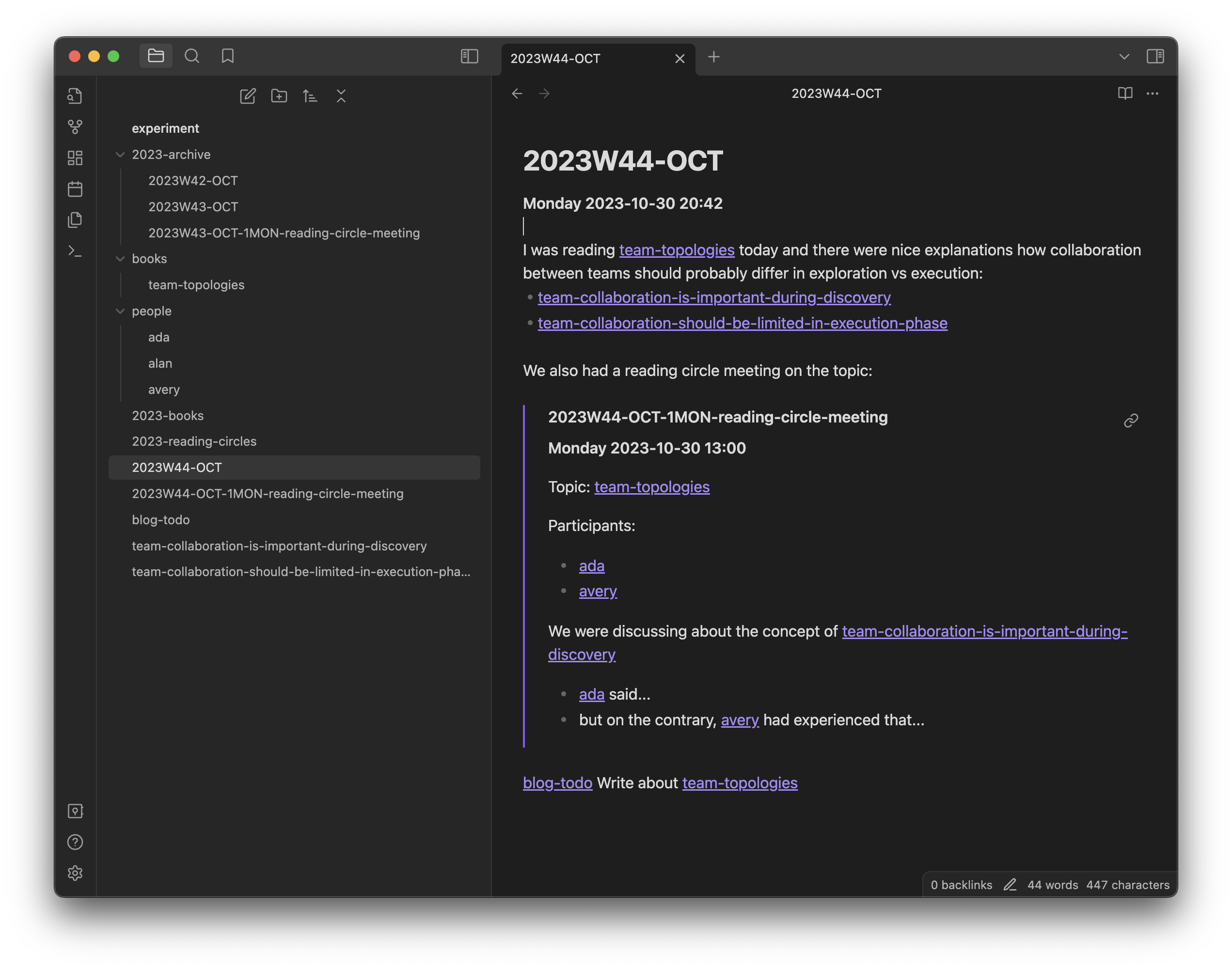
I try to list everything noteworthy in this file during the day or do some reflection in the evenings.
Events like meetings get their own separate note files, which I link to from the weekly note. Sometimes I even create the weekly note file or meeting note files beforehand and add reminders there waiting for me.
Now that I think about it, I should do it more often. It can be one way of doing a year calendar as well.
I have a separate weekly note for my diary, which is a way of separating work matters and personal life (like
2023W43-OCT-DIARY). All the notes are in the same vault so I can cross-link between them, and still easily match notes temporally (by using the consistent naming pattern).
I use a template to add time stamps inside the weekly note to mark when I wrote the note, and then it looks like this:
2023.10.27 21:00 Friday
I was writing a blog post about [[using-obsidian]].
This is what meeting or otherwise noteworthy event notes look like:
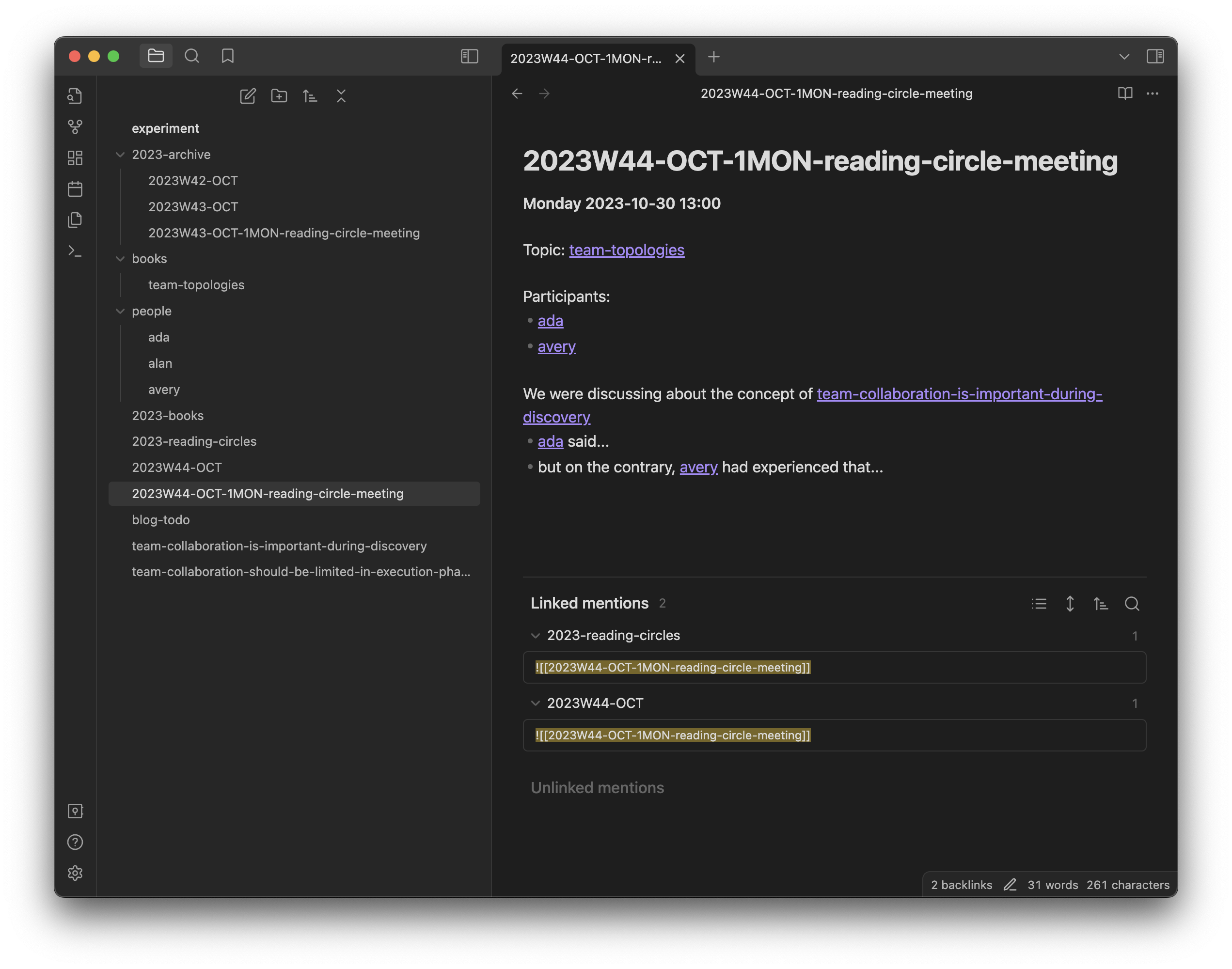
They are named something like this:
[[2023W44-OCT-1MON-reading-circle-meeting]]
1MON is my super simple convention of getting the notes sorted from Monday to Sunday.
I like that you can add the exclamation mark before the link and see the note content directly in the weekly note (see the first screenshot). That way I can still see what was talked about in the meeting while I’m in the weekly note.
That is essential for day-to-day work and makes it possible to split notes in separate files without losing the view on the whole.
And those individual notes let me link to them from multiple places, which is important in the long run. I can, for example, have a separate theme note for listing all the reading circle meetings of 2023 ([[2023-reading-circles]]) that I can link to from each of the meetings, and then I see the log in the backlinks of [[2023-reading-circles]].
Or I can list the meetings in that file and use the ”!” syntax to see full context there:
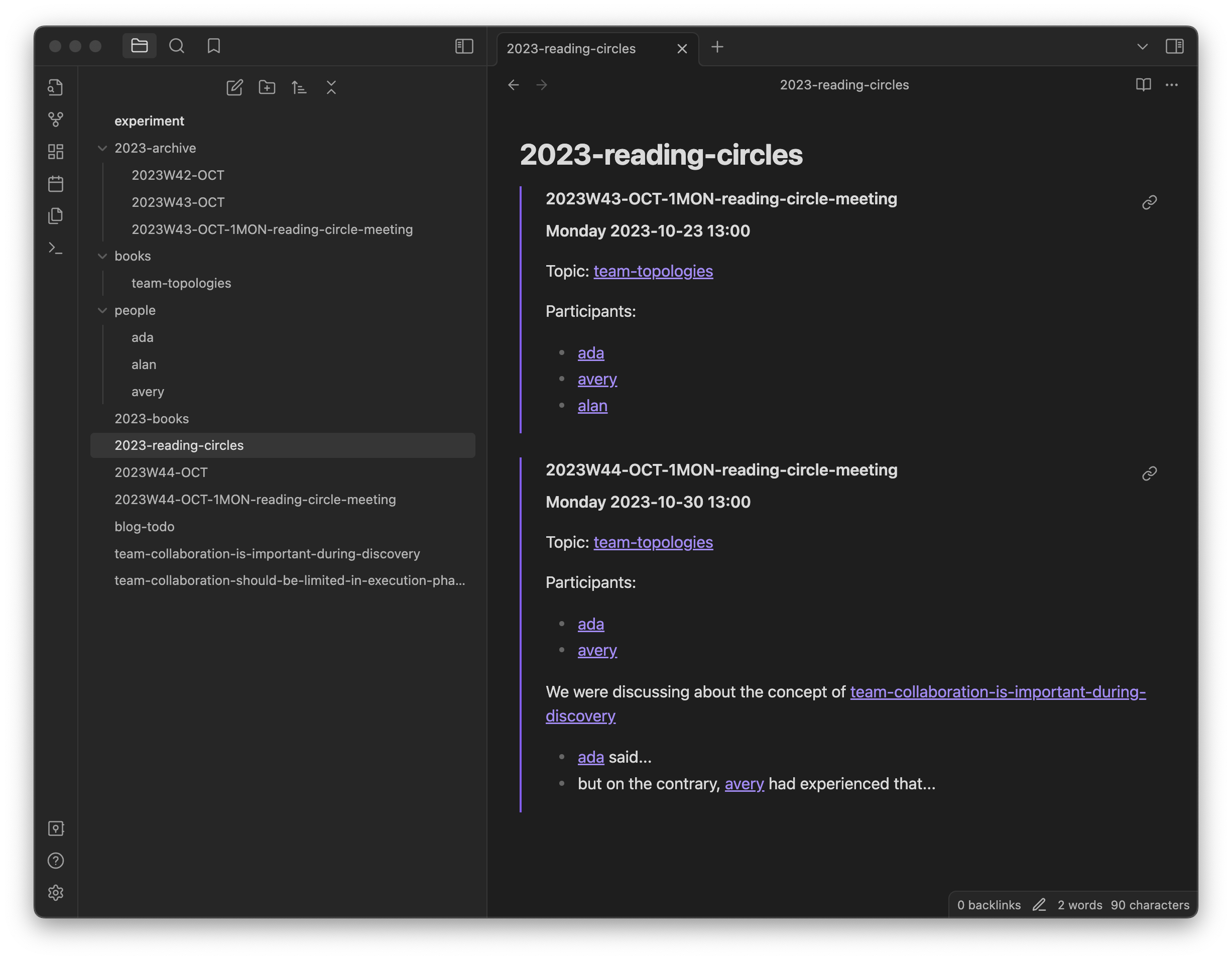
Using Obsidian for Research
Morgan has some great videos on their YouTube channel about how to use Obsidian for scientific research, I’d recommend anyone to start by watching those videos.
I try to approach teamwork from the academic research -point of view in addition to practice (working as a software developer or some kind of tech/team lead). I have used Obsidian to collect my notes about promising research papers and books, and I include page numbers to the references, but I’m still not convinced I have done this well enough.
Plagiarism is one concern: When I take a note, I should not just copy-paste the source, but write it in my own words and mix it with other sources and findings. That way it becomes a piece of writing I could at some point use in a research paper knowing I am not plagiarising and that the reference is accurate. This is not so much about learning to use Obsidian but learning to do research and scientific writing.
My study notes look like this:
team-topologies.md
A book by Manuel Pais, Matthew Skelton, 2019
![[team-collaboration-is-important-during-discovery]]
![[team-collaboration-should-be-limited-in-execution-phase]]
I have a separate note for a book, for example [[team-topologies]], and then I collect notes under it, for example:
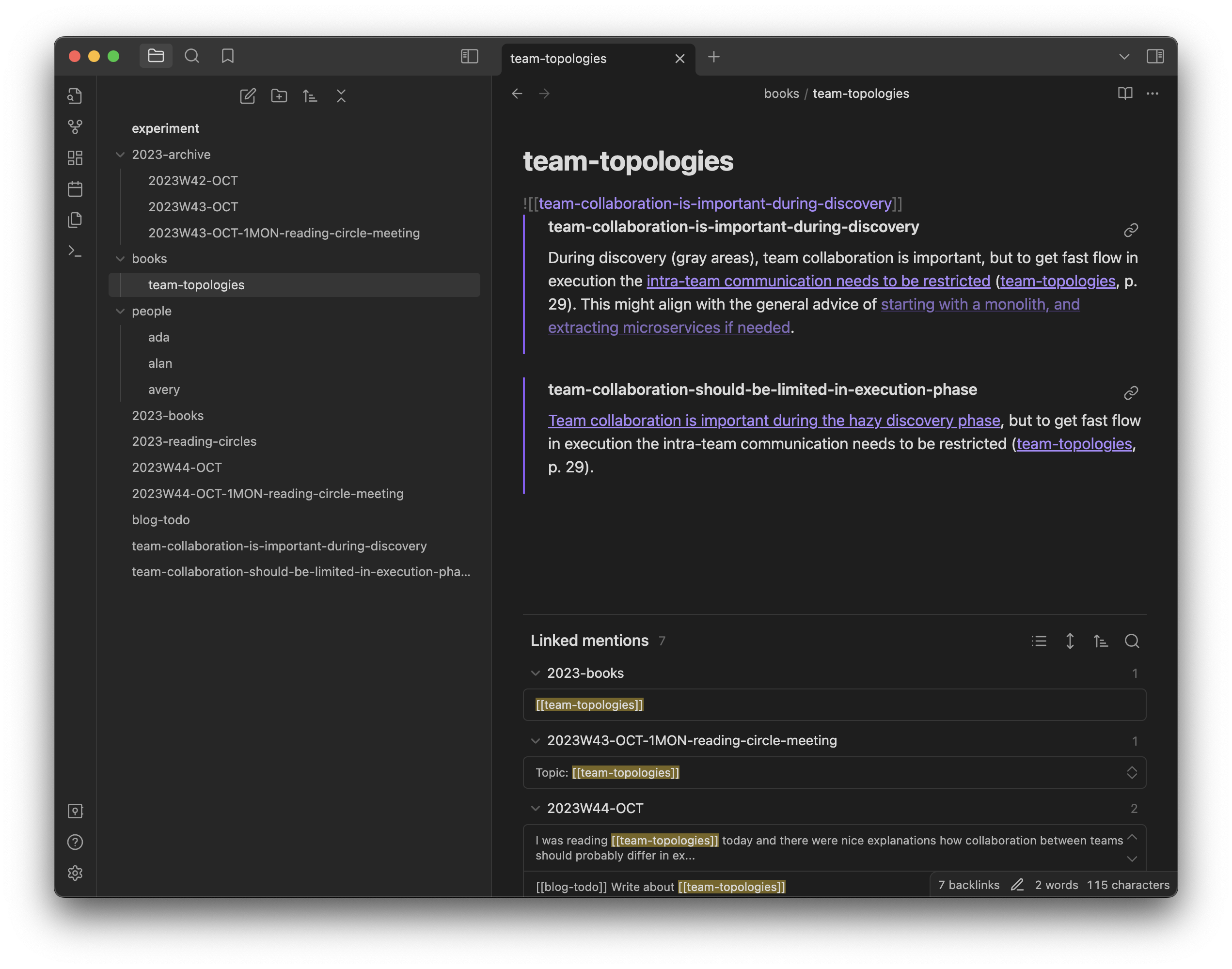
This way I have individual pieces of knowledge that have proper references, but I can also mix ideas from other sources (and my observations) to it, like here mixing team collaboration and architecture patterns:
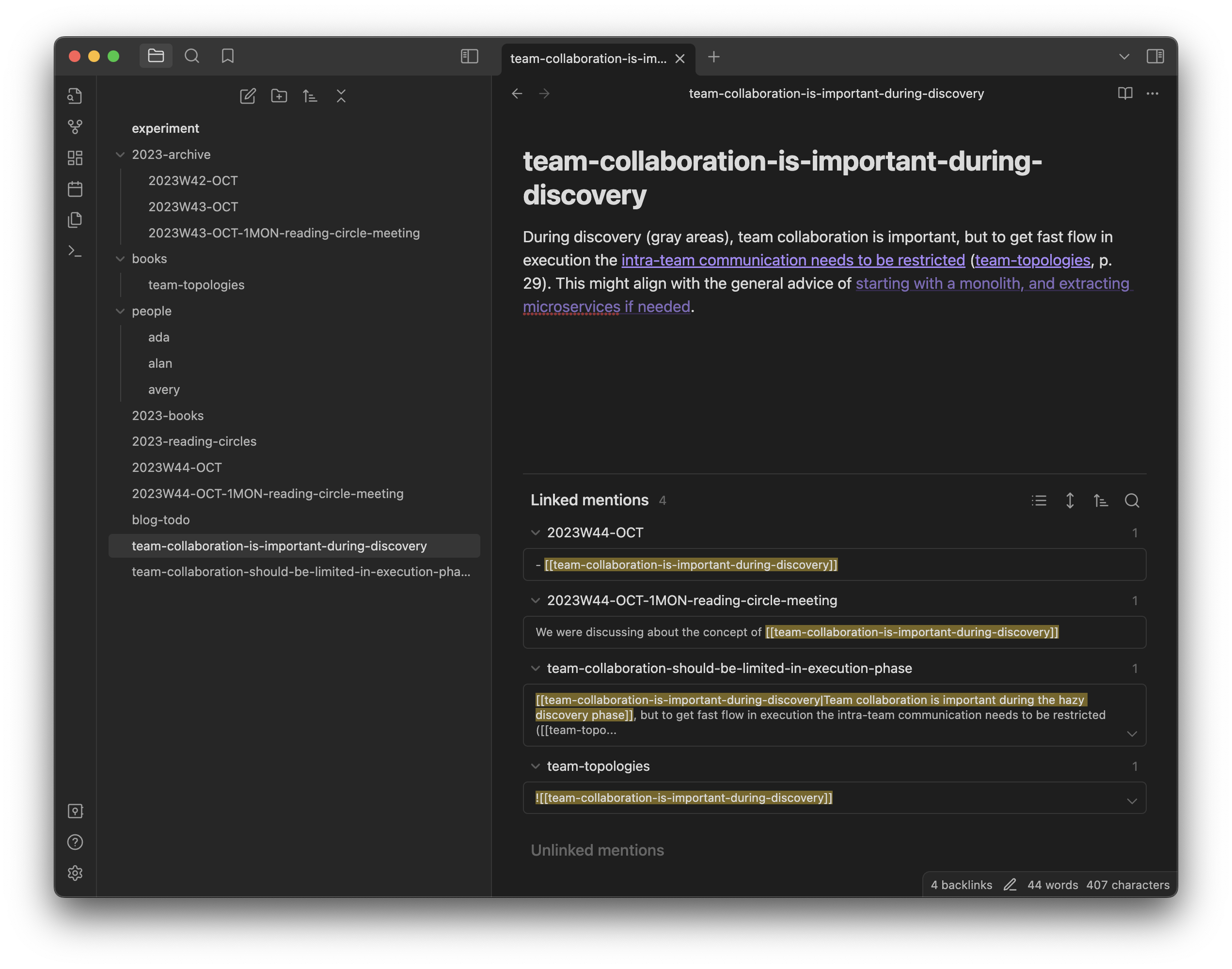
If I want to check what the Team Topologies book was about, I can open the note and see what kind of notes I made of it.
Writing it down the first time is just the beginning
This is probably the first time in my life that my notes are good enough for me to work on later as well. Trying to have individual notes for individual ideas makes it easier to improve that note later, or form a new note that is linked to it. If you have one or more pages worth of text, it takes time to get into it again later, and even longer to work on it. One paragraph on the other hand is easy to get into.
Now and then I have been going through the old notes, or I accidentally find by search that I have already run into some topic, and that is great.
I should be more intentional in refining the notes, improving the interconnectedness, and getting “finalized” pieces of knowledge. I should also create notes that collect together multiple of those knowledge pieces to form an overview of the topic. These could be constructed to help me get things done.
For example: If I need to have a kick-ass retrospective, I should have a note covering retrospectives: what I should keep in mind, and some scripts I have already tried and know to work well in a given situation. It just doesn’t make sense not to have these, considering how fast you forget the skills you are not actively using.
The Issues
I still have some unresolved rough corners in my note-taking workflow. One of the main ones is storing PDF files in Obsidian. I read a lot of PDF files and like to annotate them, and so far I have had them in GoodReads.
Obsidian would be a much better home for them, but it is not possible to work efficiently on the PDF files stored in Obsidian if you are using an iPad. I use iPad for most of my reading: I love annotating the files with Apple Pencil: highlighting and writing my notes in the margins.
I should probably form a workflow of having the in-progress PDF files in GoodNotes, and after reading those, export them to Obsidian (and deleting or achieving them from GoodNotes). Things get easily messy when you have files in multiple places, and you don’t have a single source of truth anymore.
Another unsolved issue is TODO items: You can add checkboxes to markdown with - [ ] syntax, which works alright. Finding the TODO items is not as easy. You can search with the ”- [ ]” and it works, but it would be better to have a separate view for it (I might start using Dataview for this). What I like about this is that I can add the TODO items in the note they belong to. Sometimes I’m reading some article and have an idea, and then just add a TODO note there. When I come back to that note after a few months, I can remember what my plan was.
The graph view seems to be something some people get very excited about, but I don’t use it. It could have its use in exploring the vault and trying to find orphaned notes, but so far it has not been that useful.
I like the idea of canvas, but it is not a part of my workflow yet. I might start using it for managing my work, like having a Kanban board. Canvas is a bigger feature than the graph.
Main learning so far: The format of notes
The most important thing I have learned by using Obsidian is, that I want my notes to be in relatively universal clear text Markdown format. This rules out a lot of notetaking apps in the future, but it seems to be something I need so I can feel writing notes is useful and not a wasted effort (once some company axes the service I’m using).
I have one exception to this rule: Using wikilinks. Normally you should use the relative path in links between Markdown files, but Obsidian allows you to use “wikilinks” that are just the note name. If there are multiple duplicate filenames, you need to specify the path as well. Using wikilinks is just so much easier to type, and you can move the files around without breaking the links.
I assume you can convert the links when doing an export, so this is not a big issue.
However keep in mind, that thinking your Markdown vault is easily transferable to other tools can be partly an illusion as well - if you lose the backlinks and the ability to embed files with the ”!” notation, you lose most of the value your notes have. You can experiment with that by opening your vault in a tool like Typora or Visual Studio Code.